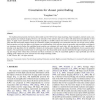Free Online Productivity Tools
i2Speak
i2Symbol
i2OCR
iTex2Img
iWeb2Print
iWeb2Shot
i2Type
iPdf2Split
iPdf2Merge
i2Bopomofo
i2Arabic
i2Style
i2Image
i2PDF
iLatex2Rtf
Sci2ools
PRL
2008
2008
Constraints for closest point finding
The traditional closest point criterion has been widely used for 3D free form shape matching, object recognition, internet search, computer graphics and medical imaging. However, the rationale of this criterion has not yet been well understood and exploited. In this paper, we apply vector operations and the triangle inequality to carefully analyse this criterion and reveal that this criterion can guarantee that the found point matches satisfy the orientation, rigidity and matching error constraints and thus, are of high relative quality. Such properties not only shed light on and deepen our understanding of this criterion about its generality and practicality and improve our awareness about whether the established point matches are consistent with each other, but also provide us with a possibility to develop novel algorithms for the reliability evaluation of existing point matches and an efficient establishment of more accurate point matches. The experimental results based on real ima...
| Added | 28 Dec 2010 |
| Updated | 28 Dec 2010 |
| Type | Journal |
| Year | 2008 |
| Where | PRL |
| Authors | Yonghuai Liu |
Comments (0)

